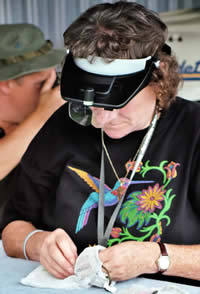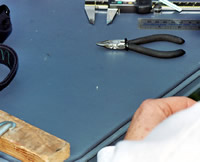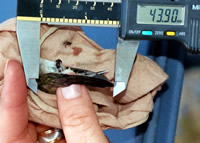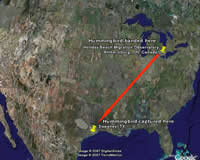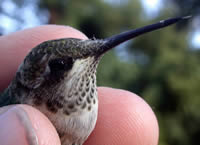A
Surprising Rubythroat Recapture From Canada to Texas By Carl A. Pascoe & Rachel A. Powless Hummingbird Banders |
|||||||||||
As you read this true story about a remarkable hummingbird journey, click on any photo to enlarge it. Next, write about and discuss questions on this Handout. We
are both hummingbird banders for the Holiday
Beach Migration Observatory (HBMO) located at Holiday Beach
Conservation Area in Ontario, Canada. Holiday Beach Conservation
Area is a park administered by the Essex Regional Conservation Authority.
They allow us to band in a special section of the park during fall
migration. The park has been designated as an Internationally Important
Bird Area because it is a major fall migration site. That’s
because the geography of this area of the Great Lakes causes a funneling
effect that focuses migrating birds through the park area.
As
volunteer hummingbird banders, you always hope that someone else
will recapture a bird you banded. Because there are only about 200
people permitted to band hummingbirds in all of North America, the
odds are not very good this will happen. About 100,000 ruby-throated
hummingbirds have been banded. Of those, only about 100 have been
recaptured by another bander. Can you figure out the ratio of birds
banded to birds recaptured? What percentage of this species have
been recaptured?
A
central part of bird banding is placing a uniquely numbered band
on a captured bird’s leg. Hummingbird bands are VERY small
and have a letter and 5 numbers. Sheets of bands are supplied by
the BBL to each bander. The bander cuts them out and sizes them
for the species of hummingbirds being banded. The band number and
all the information about the bird, including where and when it
was banded, is sent to the Bird
Banding Laboratory (BBL). They keep a central database for all
the birds that have been caught.
A
bander who re-captures a bird also submits data to the BBL. That
way, each person can find out where and by whom the bird was banded
and captured. We all follow the rules and report the event to the
BBL. Hummingbird banders also have their own communication network
on the Internet called Humband. This enables permitted banders to
freely discuss issues and problems, and share information about
this bird banding specialty. Banders will post band numbers and
ask if anyone recognizes the number. Once we knew how long between captures, the next thing was to figure out how far he traveled. What would we need to calculate the distance? Two data points are needed to determine a distance. This could be two city names, addresses, or latitude and longitude coordinates. The nearest city to Holiday Beach is Amherstburg, Ontario in Canada. Charles recaptured the bird near Sweeny, Texas.
I used
two different sites on the Internet to check my distances, and they
both gave me 1,135 miles. Canada uses the metric system of measurement
so I needed to convert the miles to kilometers. One kilometer is
equal to about 5/8th of a mile so you divide 1,135 by 5 and them
multiply by 8 to convert the miles to kilometers. It came to 1816
kilometers. The
50 mile per day estimate may have to be rethought. Of course, in
a good scientific endeavor, you need more than a single instance
to make a general hypothesis. Finding something different from what
we expect is one of the magic moments of any research. It reminds
us that science is a dynamic ever-changing process. We must base
our understanding on facts obtained using sound scientific method.
This can change as we add new verifiable information.
Special
thanks to our intrepid voyager Booker Sweeney. He graciously stopped
by Holiday Beach for his band and then made the remarkable journey
to Sweeny, Texas in such a short time. Charles R. Brower, we are
indebted to you for your efforts as a hummingbird bander that allowed
you to meet up with Booker on his sojourn. Carl and Rachel |
|||||||||||


